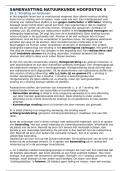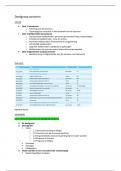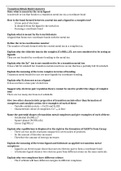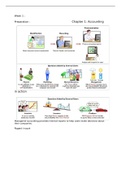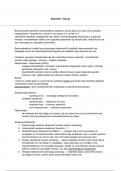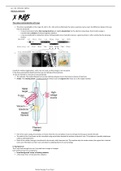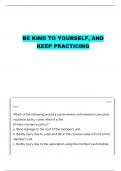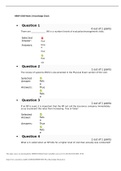EBE – YEAR 1 - MICROECONOMICS
CHAPTER 1 – PRELIMINARIES
- Microeconomics deals with the behaviour of individual economic units
o Consumers, workers, owners of land, firms
o How and why these units make decisions
▪ How firms decide to hire workers and how workers decide what and
how much of job to do
▪ How the American automobile industry developed
▪
Microeconomics – branch of economics that deals with the behaviour of
individual economic units – consumers, firms, workers and investors – as
well as the markets that these units comprise
Macroeconomics – branch of economics that deals with aggregate
economic variables, such as the level and growth rate of national output,
interest rates, unemployment, and inflation.
- The Themes of Microeconomics
o Limits → limited incomes, budgets, technological know-how, hours per week
workers can work..
o The allocation of scarce resources
o How individuals and firms can do so
- Trade-offs
o Microeconomics describes the trade-offs that consumers, workers and firms
face and shows how they are best made
o Consumers
▪ Have limited incomes
▪ How consumers (based on their preferences) maximize their well-
being by trading off the purchase of more of some goods for the
purchase of less of others
o Workers
▪ Face constraints and make trade-offs
▪ Decide whether to enter the workspace
• Working now/going to college → choice of employment
▪ How many hours per week to spend at work
o Firms
▪ Limits – kinds of products they produce
▪ They cannot produce too much – Ford Motors
▪ The theory of a firm
- Price and Markets
o The role of prices
, o How are prices determined?
▪ Centrally planned economy → determined by the government
▪ Market economy → determined by the ïnteractions of consumers,
workers and firms
o Internaction occurs in markets
- Theories and Models
o Explanation of observed phenomena
o Do firms tend to hire or lay off workers when the prices of their raw materials
change?
o Explanation is based on theories
o Theories are based on assumptions (Firms try to maximize profits)
▪ Firms chose the amounts of labour, capital and raw materials in a way
that maximizes profits
o A model is a mathematical representation – based on economic theory
o Statistic and econometrics help us to measure accuracy
o 10% drop in price of raw materials will result in approximately 5% increase in
output
o No theory is perfectly correct
- Positive versus Normative Analysis
o
Positive analysis – analysis describing relationships of cause and effect
Normative analysis – analysis examining questions of what ought to be
o Positive questions deal with explanation and prediction
o Normative questions with what ought to be (evaluate)
▪ What is the best option?
▪ Alternative policy options, also involves the design of particular policy
choices
o The use of economic theory for prediction is important for both the managers
and for public policy
- What is a Market?
o Market = central focus of analysis
o Buyers: consumers purchasing goods and services and firms purchasing
labour, capital and raw materials
, o Sellers: firms which sell their goods/services and consumers which sell their
labour and services and resource owners who rent land or sell mineral
resources
Market – collection of buyers and sellers that, through their actual or
potential interactions determine the price of a product or set of prodcuts
Market definition – determination of the buyers, sellers and range of
products that should be included in a particular market
Arbitrage – practice of buying at low price at one location and selling hight
at another
Perfectly competitive market – market with many buyers and sellers, so
that no buyer or seller gas a significant impact on price
Market price – price prevailing in a competitive market
o Market include more than an industry
▪ Industry = a collection of firms that sell the same products
o Potential buyers and sellers are as important as the actual ones
o Why do only a few firms compete with one another in some markets, while in
others a great many compete?
o Should the government intervene the markets with only a few firms?
- Competitive versus Non-competitive markets
o Most agricultural markets are close to being perfectly competitive
▪ Lot of farmers are growing wheat
o Only a small number of producers but still considered competitive – airlines
o Contain many producers but is not competitive – the world oil market – OPEC
cartel
- Market price
o Markets make possible transactions between buyers and sellers
o One price for all – corn, wheat, gold
o In market that are not perfectly competitive, firms can charge different prices
for the same product
▪ Example: laundry detergent
o Prices can fluctuate over time – sometimes rapidly
▪ Commodities which prices can dramatically rise – wheat, soybeans,
coffee, gold, oil…
- Market Definition – The Extent of a Market
o Boundaries of a market – geographically/range of products
o Housing – geographical boundaries
o Range of products – gasoline (premium and normal are in the same range →
because consumers can use both) but Diesel is not part of the market
, o Why do we need a market definition?
▪ 1. A company must understand who its actual potential competitors
are for the various products that it sells or might sell in the future. It
must also know the product boundaries and geographical boundaries
of its market in order to set price, determine advertising budgets, and
make capital investment decisions
▪ Market definition can be important for public policy decisions. Should
the government allow a merger or acquisition involning companies
that produce similar products, or should it change it? The answer
depends on the impact of the merger on future competition and
prices, often this can be evaluated only by defining a market
-
- Example 1 → Are sugar and corn sirup part of the same industry?
- Example 2 → One product and two markets
Extent of a market – boundaries of a market, both geographical and in
terms of range of products produced and sold within it
o Two different markets for bicycles → cheap and expensive
REAL VERSUS NOMINAL PRICE
Nominal price – absolute price of a good, unadjusted for inflation
Real price – price of a good relative to an aggregate measure of prices,
adjusted for inflation
Consumer price index – measure of the aggregate price level
Producer price index – measure of the aggregate products and wholesale
goods
- We want to compare the price in the past, with today´s price and what the price is
likely to be in the future
- Example: price of eggs seems higher but with inflation is actually lower
- For consumer goods – the aggregate measure of prices most often used is the
Consumer Price Index (CPI)
o How the cost of a large market basket of goods purchased by a typical
consumer changes over time
- Raw materials and other products bought by firms → we use Producer Price Index
(PPI)
o How the price change over time
- Example 3 – Calculating real prices
o Example: real price of eggs in 2016:
▪ (CPI1990/CPI2016).(nominal price in 2016)
CHAPTER 1 – PRELIMINARIES
- Microeconomics deals with the behaviour of individual economic units
o Consumers, workers, owners of land, firms
o How and why these units make decisions
▪ How firms decide to hire workers and how workers decide what and
how much of job to do
▪ How the American automobile industry developed
▪
Microeconomics – branch of economics that deals with the behaviour of
individual economic units – consumers, firms, workers and investors – as
well as the markets that these units comprise
Macroeconomics – branch of economics that deals with aggregate
economic variables, such as the level and growth rate of national output,
interest rates, unemployment, and inflation.
- The Themes of Microeconomics
o Limits → limited incomes, budgets, technological know-how, hours per week
workers can work..
o The allocation of scarce resources
o How individuals and firms can do so
- Trade-offs
o Microeconomics describes the trade-offs that consumers, workers and firms
face and shows how they are best made
o Consumers
▪ Have limited incomes
▪ How consumers (based on their preferences) maximize their well-
being by trading off the purchase of more of some goods for the
purchase of less of others
o Workers
▪ Face constraints and make trade-offs
▪ Decide whether to enter the workspace
• Working now/going to college → choice of employment
▪ How many hours per week to spend at work
o Firms
▪ Limits – kinds of products they produce
▪ They cannot produce too much – Ford Motors
▪ The theory of a firm
- Price and Markets
o The role of prices
, o How are prices determined?
▪ Centrally planned economy → determined by the government
▪ Market economy → determined by the ïnteractions of consumers,
workers and firms
o Internaction occurs in markets
- Theories and Models
o Explanation of observed phenomena
o Do firms tend to hire or lay off workers when the prices of their raw materials
change?
o Explanation is based on theories
o Theories are based on assumptions (Firms try to maximize profits)
▪ Firms chose the amounts of labour, capital and raw materials in a way
that maximizes profits
o A model is a mathematical representation – based on economic theory
o Statistic and econometrics help us to measure accuracy
o 10% drop in price of raw materials will result in approximately 5% increase in
output
o No theory is perfectly correct
- Positive versus Normative Analysis
o
Positive analysis – analysis describing relationships of cause and effect
Normative analysis – analysis examining questions of what ought to be
o Positive questions deal with explanation and prediction
o Normative questions with what ought to be (evaluate)
▪ What is the best option?
▪ Alternative policy options, also involves the design of particular policy
choices
o The use of economic theory for prediction is important for both the managers
and for public policy
- What is a Market?
o Market = central focus of analysis
o Buyers: consumers purchasing goods and services and firms purchasing
labour, capital and raw materials
, o Sellers: firms which sell their goods/services and consumers which sell their
labour and services and resource owners who rent land or sell mineral
resources
Market – collection of buyers and sellers that, through their actual or
potential interactions determine the price of a product or set of prodcuts
Market definition – determination of the buyers, sellers and range of
products that should be included in a particular market
Arbitrage – practice of buying at low price at one location and selling hight
at another
Perfectly competitive market – market with many buyers and sellers, so
that no buyer or seller gas a significant impact on price
Market price – price prevailing in a competitive market
o Market include more than an industry
▪ Industry = a collection of firms that sell the same products
o Potential buyers and sellers are as important as the actual ones
o Why do only a few firms compete with one another in some markets, while in
others a great many compete?
o Should the government intervene the markets with only a few firms?
- Competitive versus Non-competitive markets
o Most agricultural markets are close to being perfectly competitive
▪ Lot of farmers are growing wheat
o Only a small number of producers but still considered competitive – airlines
o Contain many producers but is not competitive – the world oil market – OPEC
cartel
- Market price
o Markets make possible transactions between buyers and sellers
o One price for all – corn, wheat, gold
o In market that are not perfectly competitive, firms can charge different prices
for the same product
▪ Example: laundry detergent
o Prices can fluctuate over time – sometimes rapidly
▪ Commodities which prices can dramatically rise – wheat, soybeans,
coffee, gold, oil…
- Market Definition – The Extent of a Market
o Boundaries of a market – geographically/range of products
o Housing – geographical boundaries
o Range of products – gasoline (premium and normal are in the same range →
because consumers can use both) but Diesel is not part of the market
, o Why do we need a market definition?
▪ 1. A company must understand who its actual potential competitors
are for the various products that it sells or might sell in the future. It
must also know the product boundaries and geographical boundaries
of its market in order to set price, determine advertising budgets, and
make capital investment decisions
▪ Market definition can be important for public policy decisions. Should
the government allow a merger or acquisition involning companies
that produce similar products, or should it change it? The answer
depends on the impact of the merger on future competition and
prices, often this can be evaluated only by defining a market
-
- Example 1 → Are sugar and corn sirup part of the same industry?
- Example 2 → One product and two markets
Extent of a market – boundaries of a market, both geographical and in
terms of range of products produced and sold within it
o Two different markets for bicycles → cheap and expensive
REAL VERSUS NOMINAL PRICE
Nominal price – absolute price of a good, unadjusted for inflation
Real price – price of a good relative to an aggregate measure of prices,
adjusted for inflation
Consumer price index – measure of the aggregate price level
Producer price index – measure of the aggregate products and wholesale
goods
- We want to compare the price in the past, with today´s price and what the price is
likely to be in the future
- Example: price of eggs seems higher but with inflation is actually lower
- For consumer goods – the aggregate measure of prices most often used is the
Consumer Price Index (CPI)
o How the cost of a large market basket of goods purchased by a typical
consumer changes over time
- Raw materials and other products bought by firms → we use Producer Price Index
(PPI)
o How the price change over time
- Example 3 – Calculating real prices
o Example: real price of eggs in 2016:
▪ (CPI1990/CPI2016).(nominal price in 2016)



